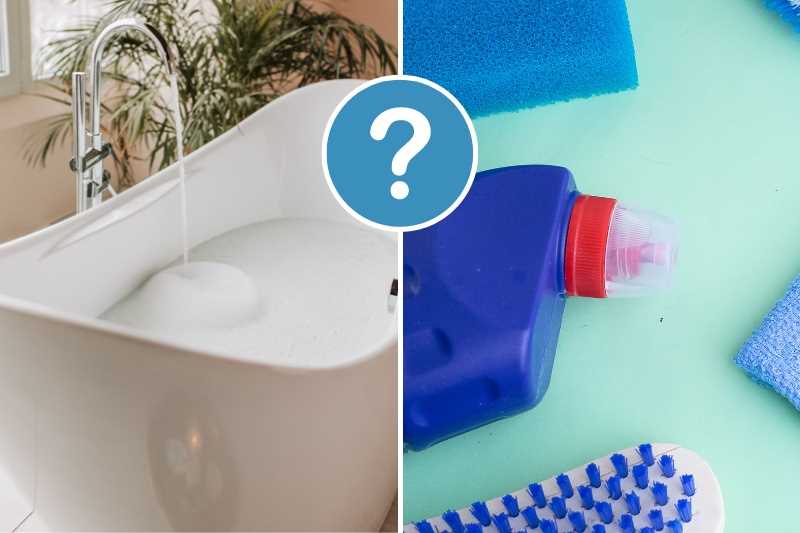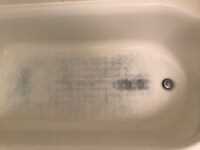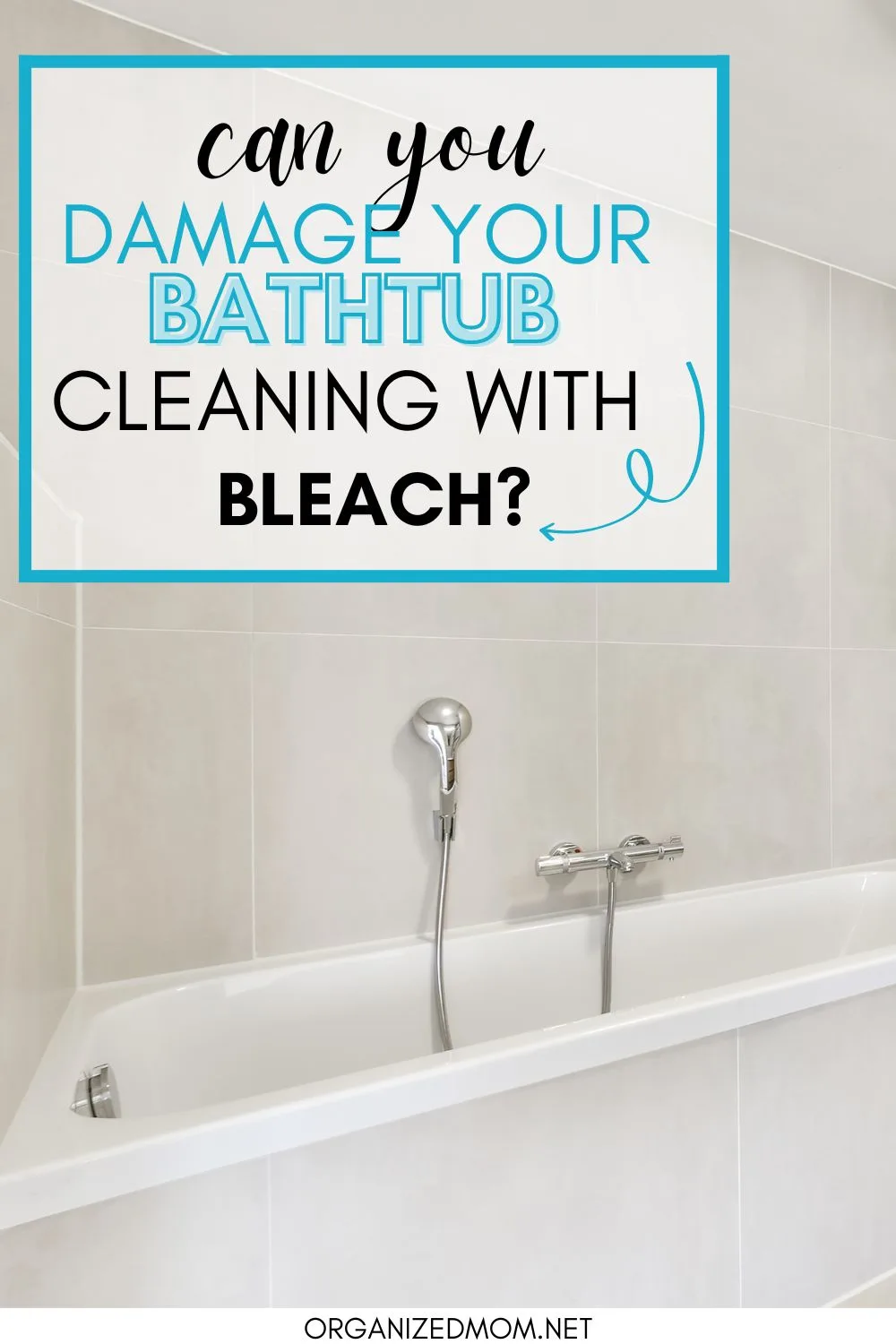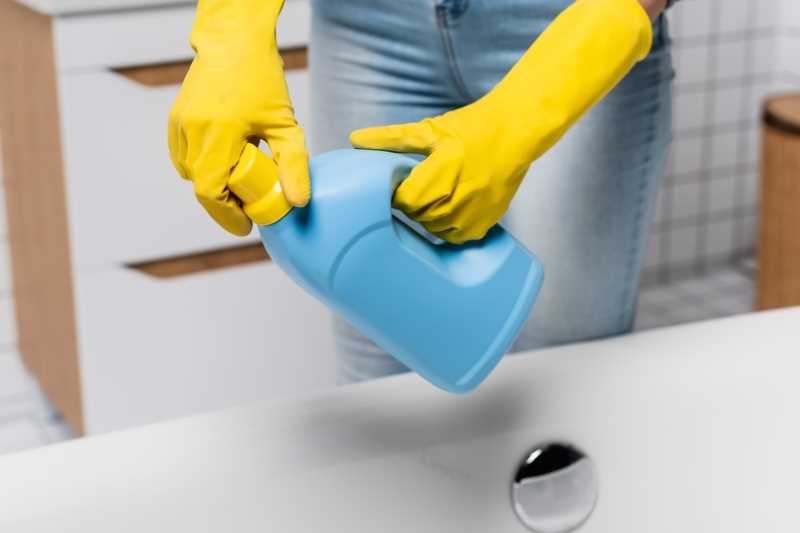




Many people rely on bleach as a powerful cleaning agent for various surfaces in their homes. From countertops to toilets, bleach is often seen as a go-to solution. But what about using bleach on bathtubs? Does it have any negative effects on this particular fixture? In this article, we will explore the impact of bleach on your tub and whether or not it can cause damage.
It’s important to understand that bleach is a harsh chemical. Its primary function is to kill bacteria and remove stubborn stains. However, the active ingredient in bleach, sodium hypochlorite, can be corrosive when used excessively or left to sit on surfaces for extended periods of time. This raises concerns about the potential damage it can cause to bathtubs, which are typically made from materials like porcelain, acrylic, or fiberglass.
Porcelain bathtubs are generally more resistant to the corrosive effects of bleach compared to acrylic or fiberglass tubs. Porcelain is an extremely durable material that can withstand regular exposure to bleach. However, it’s important to note that even porcelain has its limits. Repeated and frequent application of bleach can cause the protective glaze on porcelain tubs to wear down, making it more susceptible to scratches and stains over time.
Acrylic and fiberglass bathtubs, on the other hand, are more vulnerable to the corrosive nature of bleach.
Top RatedRenotub Premium Bath Resurfacing KitQuick drying enamel for durable finishesThis premium resurfacing kit includes everything you need for a flawless bathtub finish, combining a brilliant white coating with a handy brush cleaner. Enjoy a high-gloss, hard-wearing result that's easy to apply.Bleach can cause these tubs to become discolored, fade, or even develop cracks. The chemicals in bleach can break down the materials used in acrylic and fiberglass, leading to permanent damage. If you have an acrylic or fiberglass tub, it’s best to avoid using bleach or use it sparingly and with caution.
In conclusion, while bleach can be an effective cleaning agent for bathtubs, it’s essential to use it responsibly and consider the material of your tub. If you have a porcelain tub, moderate use of bleach should not cause significant damage. However, if you have an acrylic or fiberglass tub, it’s best to explore alternative cleaning methods to avoid potential harm.
Understanding the Effect of Bleach on Bathtubs
Bleach is a commonly used household cleaning product that has many applications, including removing stains, disinfecting surfaces, and brightening fabrics. However, when it comes to using bleach on bathtubs, there are some important factors to consider.
Chemical Composition
Bleach contains chemicals such as sodium hypochlorite, which is a strong oxidizing agent. When bleach comes into contact with organic compounds like dirt, grime, or bacteria, it breaks them down into smaller, less harmful molecules.
Impact on Bathtub Materials
The effect of bleach on bathtubs depends on the material from which the tub is made. Let’s explore the common bathtub materials and how they are affected by bleach:
- Porcelain: Porcelain bathtubs are generally resistant to bleach and can handle regular cleaning with bleach-based products. However, prolonged exposure or using undiluted bleach may cause discoloration or fading of the porcelain surface.
- Acrylic: Acrylic bathtubs are more sensitive to bleach compared to porcelain. While bleach can be used to clean acrylic tubs, it should be diluted and not left on the surface for extended periods. Using concentrated bleach or leaving it on the acrylic surface for too long may result in discoloration, etching, or even cracking.
- Fiberglass: Fiberglass bathtubs are also susceptible to damage from bleach. Undiluted bleach or leaving bleach on the surface for an extended period can cause the fiberglass to become brittle, crack, or even develop a chalky appearance.
Precautions and Recommendations
To minimize potential damage to your bathtub when using bleach, consider the following precautions:
- Dilute the bleach: Always dilute bleach with water according to the recommended ratios. Avoid using undiluted bleach on your bathtub.
- Use gloves and ventilation: When handling bleach, it’s important to protect your skin by wearing gloves and ensuring proper ventilation in the bathroom.
- Test a small area: Before applying bleach to the entire bathtub, test it on a small, inconspicuous area to check for any adverse reactions or damage.
- Maintain regular cleaning: Regular cleaning and maintenance can prevent the buildup of dirt and grime, reducing the need for heavy bleach cleaning.
Alternative Cleaning Methods
If you’re concerned about using bleach on your bathtub or want to explore alternative cleaning methods, there are several options available. These include using baking soda, vinegar, hydrogen peroxide, or mild dish soap mixed with water.
| Method | Description |
|---|---|
| Baking soda | Make a paste by mixing baking soda and water. Apply to the bathtub surface and scrub gently with a sponge or cloth. |
| Vinegar | Mix equal parts vinegar and water in a spray bottle. Spray the solution onto the tub surface, let it sit for a few minutes, then scrub and rinse. |
| Hydrogen peroxide | Dilute hydrogen peroxide with water in a spray bottle. Spray onto the tub surface, let it sit for a few minutes, then scrub and rinse. |
| Mild dish soap | Mix a few drops of mild dish soap with water. Apply to the tub surface, scrub gently with a sponge or cloth, then rinse. |
These alternative cleaning methods can be effective in removing stains and grime without the potential risks associated with bleach.
In conclusion, while bleach can be used to clean bathtubs, it’s important to understand the effect of bleach on different materials and take precautions to avoid damaging your tub. Exploring alternative cleaning methods may also be a good option for those who prefer to avoid using bleach.
Signs of Damage Caused by Bleach
Using bleach to clean your bathtub can be an effective way to remove stains and kill germs. However, it’s important to be aware of the potential damage that bleach can cause to your tub. Here are some signs to look out for:
1. Discoloration
- If you notice any changes in the color of your bathtub, such as yellowing or fading, it could be a sign that bleach has caused damage. Bleach has a bleaching effect on many surfaces, including bathtub materials like porcelain or acrylic.
- Discoloration may occur over time with regular use of bleach, especially if it is not properly diluted or if the tub is not rinsed thoroughly after cleaning.
2. Cracks or Chips
- Excessive use of bleach or using bleach that is too concentrated can weaken the structure of your bathtub, leading to cracks or chips.
- If you notice any visible damage, such as small cracks or chips, it’s important to address them promptly to prevent further deterioration.
3. Etching
- Bleach can cause etching on certain surfaces, particularly on bathtub finishes like enamel or fiberglass. Etching appears as rough or pitted areas on the surface of the tub.
- Etching can occur if bleach is left on the surface for too long or if abrasive cleaning tools are used in conjunction with bleach.
4. Loss of Shine
- If your bathtub starts to lose its shine or appear dull, it could be a sign of damage caused by bleach.
- Bleach can strip away the protective coating on bathtub surfaces, leaving them vulnerable to further damage and making them more difficult to clean in the future.
If you notice any of these signs of damage after using bleach to clean your bathtub, it’s important to take appropriate action. This may include repairing any visible damage, using alternatives to bleach for future cleaning, or seeking professional advice.
Preventing and Minimizing Bleach Damage
1. Dilute the bleach
To minimize the damage bleach can cause to your bathtub, try diluting it with water before using it. This will reduce the concentration of bleach and make it less likely to cause any damage.
2. Ventilate the area
When using bleach, it is important to have proper ventilation in the bathroom. Open a window or use an exhaust fan to ensure that the fumes don’t build up and cause damage to your tub or other surfaces.
3. Limit contact time
Try to limit the amount of time that bleach is in contact with your bathtub. Apply the bleach, scrub the surface, and rinse it off promptly to prevent any prolonged exposure that could potentially cause damage.
4. Test in an inconspicuous area
Before applying bleach to the entire surface of your bathtub, it is recommended to test it in a small, inconspicuous area. This will allow you to assess the impact of the bleach and determine if any damage occurs.
5. Use alternative cleaners
If you are concerned about the impact of bleach on your bathtub, consider using alternative cleaning products that are less likely to cause damage. There are many commercially available cleaners that can effectively remove stains and dirt without the use of bleach.
6. Regular maintenance
To prevent the need for harsh cleaners like bleach, it is important to regularly maintain and clean your bathtub. By regularly removing dirt and grime, you can reduce the chances of needing to resort to stronger cleaning agents.
7. Use protective coatings
If you are particularly concerned about bleach damage, you can consider applying a protective coating to your bathtub. There are various products available that can create a barrier between the bleach and the surface of the tub, reducing the risk of damage.
8. Seek professional advice
If you are unsure about how to properly clean and maintain your bathtub or if you have already experienced bleach damage, it is often helpful to seek professional advice. A professional cleaner or bathroom specialist can provide guidance on the best methods and products to use in your specific situation.
Alternative Cleaning Solutions for Bathtubs

Vinegar and Baking Soda
If you are looking for an alternative cleaning solution for your bathtub that is safe and effective, vinegar and baking soda can be a great option. Simply mix equal parts of white vinegar and baking soda to create a paste. Apply this paste to the surfaces of your bathtub and let it sit for a few minutes. Then, scrub the bathtub using a soft brush or sponge and rinse it thoroughly with water. Vinegar and baking soda can help remove stains, soap scum, and dirt without causing any damage to your bathtub.
Lemon Juice
Lemon juice is another natural and eco-friendly alternative for cleaning bathtubs. It contains citric acid, which can help break down soap scum and remove stains. Squeeze fresh lemon juice onto a sponge or cloth and apply it to the surfaces of your bathtub. Let it sit for a few minutes, then scrub the bathtub using a soft brush or sponge. Rinse the bathtub thoroughly with water to remove any residue. Lemon juice not only cleans your bathtub effectively but also leaves a fresh citrus scent.
Borax

Borax, also known as sodium borate, is a natural mineral that can be used to clean bathtubs. Mix 1/4 cup of borax with a small amount of water to create a paste-like consistency. Apply this paste to the surfaces of your bathtub and scrub gently using a soft brush or sponge. Let it sit for a few minutes, then rinse the bathtub thoroughly with water. Borax is a gentle yet effective cleaning agent that can help remove soap scum, stains, and grime.
Hydrogen Peroxide
Hydrogen peroxide is a powerful cleaning agent that can be used to remove tough stains and disinfect your bathtub. Mix equal parts of hydrogen peroxide and water in a spray bottle. Spray this solution onto the surfaces of your bathtub and let it sit for a few minutes. Then, scrub the bathtub using a soft brush or sponge and rinse it thoroughly with water. Hydrogen peroxide can help eliminate mold, mildew, and bacteria without causing any damage to your bathtub.
Commercial Eco-friendly Cleaners

If you prefer using commercial cleaners, there are eco-friendly options available on the market. Look for cleaners that are specifically formulated for bathtubs, free from harsh chemicals, and environmentally friendly. Read the labels and instructions carefully before using any product and ensure that they are safe for use on your specific bathtub material.
In conclusion, there are several alternative cleaning solutions for bathtubs that are safe, effective, and eco-friendly. Whether you choose to use vinegar and baking soda, lemon juice, borax, hydrogen peroxide, or commercial eco-friendly cleaners, you can keep your bathtub clean without worrying about damaging its surface.
Ensuring the Longevity of Your Bathtub

Cleaning Tips
- Use non-abrasive cleaners: When cleaning your bathtub, avoid using harsh or abrasive cleaners that can cause damage. Instead, opt for gentle cleansers that are specifically formulated for bathtubs.
- Avoid bleach: While bleach is a powerful cleaner, it can be damaging to your bathtub surface over time. It is best to avoid using bleach or to use it sparingly.
- Regular maintenance: Make it a habit to clean your bathtub regularly to prevent the buildup of grime and soap scum. This will help to maintain the integrity of the surface and prevent stains from setting in.
Preventive Measures
- Use a shower mat: Placing a shower mat in your tub can help to prevent scratches and dents caused by heavy or sharp objects.
- Avoid dropping heavy objects: Be mindful when handling heavy objects in the bathroom, as dropping them can cause damage to the tub surface.
- Don’t use the tub as a storage space: Avoid placing heavy items or storing products directly on the surface of your bathtub, as this can lead to marks and scratches.
Maintenance and Repair
Even with regular care, your bathtub might require some additional maintenance and repair over time to ensure its longevity.
- Inspect for cracks or chips: Periodically check your bathtub for any cracks or chips. If you notice any, it’s important to address them promptly to prevent further damage.
- Resurfacing: If your bathtub’s surface becomes worn or damaged, consider hiring a professional to resurface it. This process involves applying a fresh layer of coating to restore its appearance and durability.
- Sealant maintenance: If your bathtub has a sealant around the edges or seams, regularly inspect and maintain it. Over time, the sealant can deteriorate, leading to leaks and potential water damage.
Professional Assistance
If you’re unsure about the best cleaning methods or if your bathtub requires repair, it’s always a good idea to consult with a professional. They can provide expert advice and assist with any necessary repairs or maintenance tasks.
Conclusion
By following proper cleaning techniques, taking preventive measures, and addressing any necessary maintenance or repair promptly, you can ensure the longevity of your bathtub. It will not only stay looking its best but also provide you with years of enjoyable use.
FAQ
Will using bleach damage my bathtub?
Yes, using bleach can potentially damage your bathtub. Bleach is a strong chemical that can cause scratches and discolouration on certain materials, especially if it is used frequently or left on the surface for too long.
What types of bathtubs are most vulnerable to bleach damage?
Acrylic and enamel bathtubs are most vulnerable to bleach damage. These materials are more prone to scratches and can become discoloured when exposed to bleach.
How can I clean my bathtub without using bleach?
There are several alternatives to bleach for cleaning your bathtub. You can use natural cleaners like vinegar or baking soda mixed with water, or you can try using mild dish soap. These options are generally safer for your bathtub and can still effectively remove dirt and grime.
Is there a safe way to use bleach on my bathtub?
If you want to use bleach on your bathtub, it is best to dilute it with water. This will reduce its strength and minimize the risk of damage. Additionally, make sure to rinse the bathtub thoroughly after using bleach to remove any residue.
Can I use bleach on a fiberglass bathtub?
It is generally not recommended to use bleach on a fiberglass bathtub. While bleach may be effective in cleaning the surface, it can cause discolouration and weaken the structure of the fiberglass over time.
What should I do if my bathtub is already damaged by bleach?
If your bathtub is already damaged by bleach, you may need to consider repairing or refinishing the surface. Consult a professional for the best course of action based on the specific type of damage.












